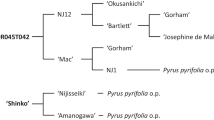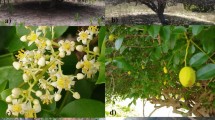Abstract
Graft failure that occurs in the clonal propagation of chestnuts is a practical problem which has arisen in recent years. Several hypotheses have been put forward to explain reasons for the failure but none have focused on origin and relationships of cultivars. This study was carried out to determine whether relationships of New Zealand chestnut selections and their origin reflect patterns of graft failure within the selections. Two different character data sets, random amplified polymorphic DNA (RAPD) and morpho-nut, were employed for the analyses of the relationships between the chestnut selections. Four different analyses were done to generate trees depicting the relationships of the selections. These were: morpho-nut character, RAPD character, taxonomic congruence (combination of morpho-nut and RAPD trees), and character congruence (combination of morpho-nut and RAPD data sets). When graft failure data were mapped onto the majority rule consensus tree constructed from character congruence analysis, it was found that self graft incompatibility was reflected in the origin and relationships of the chestnut selections. Information on the affinities of the chestnut selections to introduced chestnut species showed that the selections that were mostly implicated in graft failure which are from the North Island had affinities with theCastanea crenata species. But the selections (from the South Island) that were placed withCastanea sativa as well as hybrids (“1002” and “1007” from the North Island) ofCastanea mollissima andC. crenata had no failed grafts. This finding indicates that graft failure in New Zealand chestnut selections does not occur by chance but is dependent on the origin and/or evolutionary history of the selections.
Similar content being viewed by others
References
Baum B. R. (1992) Combining trees as a way of combining data sets for phylogenetic inference, and the desirability of combining gene trees. Taxon 41: 3–10.
Desvignes J. C. (1989) Progression of cherry leaf roll virus through walnuts and the formation of black line -2éme Colloque Noyer-Noisetier, Agrimed Bordeaux Public CEE EUR 12005: 17–23. [In French]
Doyle J. J., Doyle J. R. (1987) A rapid DNA isolation procedure for small quantities of fresh tissue. Phytochem. Bull. 19: 1–15.
Faith D. P., Cranston P. S. (1991) Could a cladogram this short have arisen by chance alone? On permutation tests for cladistic structure. Cladistics 7: 1–28.
Goldsbrough G. (1990) A beginner's guide to chestnut growing. Hilton Press, Auckland, New Zealand.
Hardy M. B. (1960) The propagation of Chinese chestnut trees. Rep. Annual N. Nut Growers' Assoc. 51: 36–40.
Howat J. I. (1992) History and structure of the NZ chestnut industry. In: Proceedings of the NZ Chestnut Conference, Hamilton, New Zealand, pp. 1–10. Hort Research Conference hall, Hamilton, New Zealand Chestnut Council Inc.
Huang H. H., Norton J. D., Boyhan G. E., Abrahams B. R. (1994) Graft compatibility among chestnut (Castanea) species. J. Amer. Soc. Hort. Sci. 119: 1127–1132.
Jaynes R. A. (1961) Genetic and cytological studies in the genusCastanea Doctoral Dissertation. Yale University, New Haven, Connecticut.
Kim K. J., Jansen R. K. (1994) Comparisons of phylogenetic hypotheses among different data sets in dwarf dandelions (Kirgia, Asteraceae): additional information from internal transcribed spacer sequences of nuclear ribosomal DNA. Plant Syst. Evol. 190: 157–185.
Klinac D. J., Lelieveld J. F., Knowles R. D. (1995). Time of flowering and pollination in some New Zealand chestnut selections, and introduced cultivars. New Zealand J. Crop Hort. Sci. 23: 331–340.
Kluge A. G. (1989) A concern for evidence and a phylogenetic hypothesis of relationships amongEpicrates (Boidae,Serpentes). Syst. Zool. 18: 1–32.
Lanyon S. M. (1993) Phylogenetic frameworks: Towards a firmer foundation for the comparative approach. Biol. J. Linn. Soc. 49: 45–61.
Maddison W. P., Maddison D. R. (1993) MacClade 3.1 Interactive analysis of phylogeny and character evolution. Sinauer, Sunderland, Mass.
Minitab (1994) Release 10.1 Computer Services Centre, Lincoln University, Lincoln, New Zealand.
Nelson G. J., Plantnick N. (1981) Systematics and biogeography: Cladistics and vicariance. Columbia University Press, New York.
Oraguzie N. C. (1997) Phylogenetic relationships among New Zealand chestnut selections and the relationships with graft failure. Ph. D. Thesis, Lincoln University, New Zealand.
Oraguzie N. C., McNeil D. L., Klinac D. J., Knowles R. D., Sedcole R. J. (1998a) Relationships of chestnut species and New Zealand chestnut selections using morpho-nut characters. Euphytica 99: 27–33.
Oraguzie N. C., McNeil D. L., Paterson A. M., Chapman H. (1998b) Comparison of RAPD and morpho-nut characters for revealing genetic relationships between chestnut species and New Zealand chestnut selections. New Zealand J. Crop Hort. Sci. 26: 109–115.
Oraguzie N. C., McNeil D. L., Thomas M. B. (1998c) Examination of graft failure in New Zealand chestnut selections. Sci. Hort. 76: 89–103.
Page R. D. M. (1990) Component analysis: a valiant failure? Cladistics 6: 119–136.
Page R. D. M. (1992) Component user manual (Release 2.0). Natural History Museum, London.
Rohlf F. J. (1982) Consensus indices for comparing classifications. Math. Biosci. 59: 131–144.
Rutter P. A., Miller G., Payne J. A. (1990) Chestnuts (Castanea) Acta Hort. 290: 761–768.
Shaffer H. B., Clark J. M., Kraus F. (1991) When molecules and morphology clash: a phylogenetic analysis of the North American ambystomatid salamanders (Caudata:Ambystomatidae). Syst. Zool. 40: 284–303.
Swofford D. L. (1993) PAUP: Phylogenetic analysis using parsimony, version 3.1. Illinois Natural History Survey, Champaign, Ill.
Vane-Wright R. I., Schulz S., Boppre M. (1992) The cladistics ofAmauris butterflies: congruence, consensus and total evidence. Cladistics 8: 125–138.
Williams J. G. K., Kubelik A. R., Livak K. J., Rafalaski J. A., Tingey S. V. (1990) DNA polymorphism amplified by arbitrary primers are useful as genetic markers. Nucl. Acids. Res. 18: 6531–6535.
Author information
Authors and Affiliations
Rights and permissions
About this article
Cite this article
Oraguzie, N.C., Paterson, A.M. & McNeil, D.L. Origin and relationships of New Zealand chestnut (Castanea sp.Fagaceae) selections reflect patterns of graft failure. Pl Syst Evol 218, 193–204 (1999). https://doi.org/10.1007/BF01089227
Received:
Accepted:
Issue Date:
DOI: https://doi.org/10.1007/BF01089227




